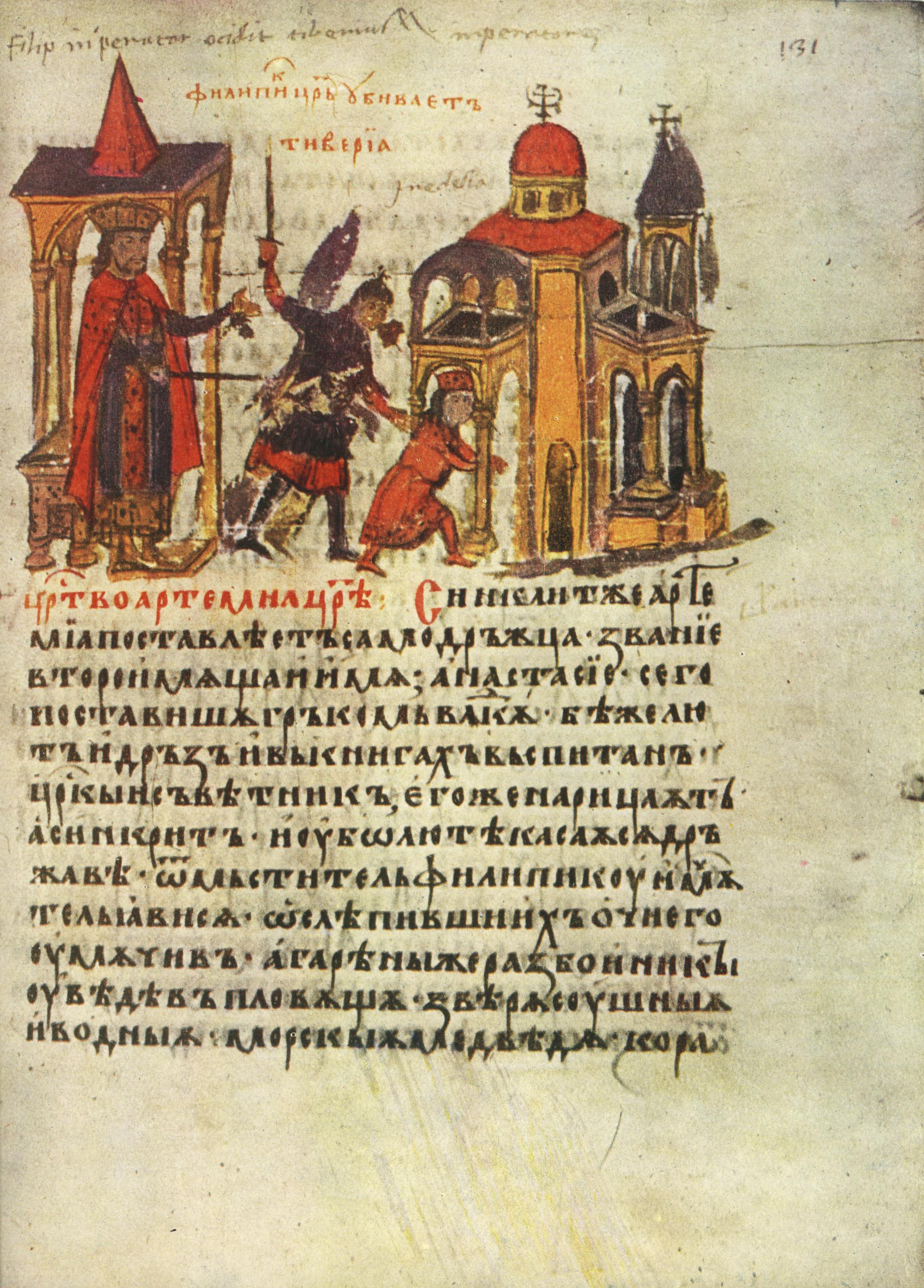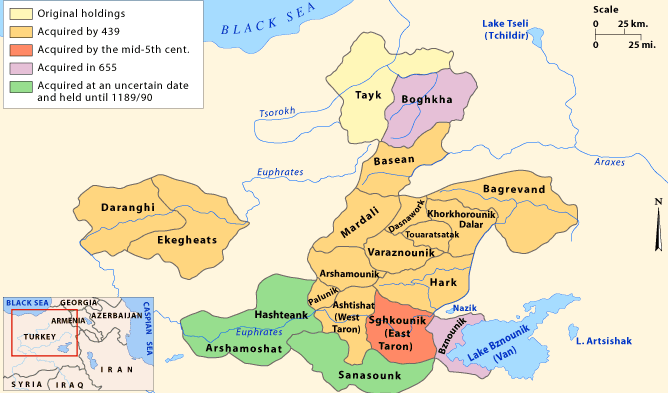|
Philippikos
Philippicus (; ), born Bardanes (; ) was Byzantine emperor from 711 to 713. He took power in a coup against the unpopular emperor Justinian II, and was deposed in a similarly violent manner nineteen months later. During his brief reign, Philippicus supported monothelitism in Byzantine theological disputes, and saw conflict with the First Bulgarian Empire and the Umayyad Caliphate. Biography Philippicus was originally named Bardanes (; ); he was the son of the patrician Nicephorus, who was of Armenian extraction from an Armenian colony in Pergamum. The Armenian background of Philippicus has been supported by Byzantinist historians Peter Charanis and Nicholas Adontz, and disputed by Anthony Kaldellis. Kaldellis adds that Bardanes was probably born and raised in the Byzantine realm, as his father Nicephorus possibly was. Contemporaneous sources attest to Bardanes' tutoring, scholarly interests, learning and eloquence, all of which were in Greek. Byzantine historians Leslie Brubaker ... [...More Info...] [...Related Items...] OR: [Wikipedia] [Google] [Baidu] |
Justinian II
Justinian II (; ; 668/69 – 4 November 711), nicknamed "the Slit-Nosed" (), was the last Byzantine emperor of the Heraclian dynasty, reigning from 685 to 695 and again from 705 to 711. Like his namesake, Justinian I, Justinian II was an ambitious and passionate ruler who was keen to restore the Roman Empire to its former glories. However, he responded brutally to any opposition to his will and lacked the finesse of his father, Constantine IV. Consequently, he generated enormous opposition to his reign, resulting in his deposition in 695 in a popular uprising. He only returned to the throne in 705 with the help of a Bulgar and Slav army. His second reign was even more despotic than the first, and in 711 he was killed by mutinous soldiers. First reign Justinian II was the eldest son of Emperor Constantine IV and Anastasia. His father appointed him as his heir sometime after October 682, upon the deposition of his uncles Heraclius and Tiberius. In 685, at the age of sixteen, J ... [...More Info...] [...Related Items...] OR: [Wikipedia] [Google] [Baidu] |
Anastasius II (emperor)
Anastasius II (; died 719), born Artemius (, was the Byzantine emperor from 713 to 715. His reign was marked by significant religious and political decisions aimed at stabilizing the Empire. One of his notable actions was reversing the previous appointment of a Monothelete patriarch of Constantinople, instead reinstating Orthodoxy by appointing Germanus I to the position. This move was made in an effort to gain the favor of Pope Constantine. Anastasius II dedicated his efforts to fortifying the Empire and fostering a period of stability. However, his reign was cut short when he was deposed by Theodosius III during the Byzantine campaign against the Umayyad Caliphate in 715. Undeterred, four years later, in 719, Anastasius launched a rebellion against Leo III the Isaurian in a bid to reclaim the imperial throne. Initially, Anastasius received support from Tervel of Bulgaria, who provided soldiers and funds for his cause. However, the situation took a turn when Anastasius failed ... [...More Info...] [...Related Items...] OR: [Wikipedia] [Google] [Baidu] |
Philippicus (comes Excubitorum)
Philippicus (; fl. 580s–610s) was an Eastern Roman general, ''comes excubitorum'', and brother-in-law of Emperor Maurice (r. 582–602). His successful career as a general spanned three decades, chiefly against the Sassanid Persians. Career under Maurice Little is known about Philippicus's early years. He was married to Gordia, sister of Emperor Maurice (reigned 582–602), probably in 583,. and was at some point raised to the high rank of '' patricius''.. At about the same time, he was appointed ''comes excubitorum'' (Commander of the Excubitors, the imperial bodyguard), and in 584, he replaced John Mystacon as ''magister militum'' for the East, thus becoming responsible for the conduct of the ongoing war against the Sassanid Persians. He commanded numerous raids into Persian territory in 584–585, ravaging the plains near Nisibis, and making inroads in the regions of Arzanene and eastern Mesopotamia.. During the same period, he actively tried to improve the disciplin ... [...More Info...] [...Related Items...] OR: [Wikipedia] [Google] [Baidu] |
Mamikonian
Mamikonian or Mamikonean () was an Armenian aristocratic dynasty which dominated Armenia between the 4th and 8th centuries—through the late antique kingdom, Sasanian, Byzantine, and Arab dominations. They were the most notable noble house in early Christian Armenia after the ruling Arsacids and held the hereditary positions of (supreme commander of the army) and (royal tutor), allowing them to play the role of kingmaker for the later Armenian kings. They ruled over extensive territories, including the Armenian regions of Tayk, Taron, Sasun, and Bagrevand, among others. The Mamikonians had a reputation as supporters of the Roman (and later Byzantine) empire in Armenia against Sasanian Iran, although they also served as viceroys under Persian rule. Their influence over Armenian affairs began to decline at the end of the 6th century and suffered a final, decisive blow after a failed rebellion against Arab rule over Armenia in 774/75. Origin The origin of the Mamikonian ... [...More Info...] [...Related Items...] OR: [Wikipedia] [Google] [Baidu] |
Peter Charanis
Peter Charanis (1908 – 23 March 1985), born Panagiotis Charanis (), was a Greek-born American scholar of Byzantium and the Voorhees Professor of History at Rutgers University. Charanis was long associated with the Dumbarton Oaks research library. Biography Charanis was born in Lemnos, Ottoman Greece. He immigrated to the United States as a pre-teen leaving his family in Lemnos and settling in New Jersey in 1920. He received his bachelor's degree from Rutgers and his doctorate from the University of Wisconsin–Madison, where he studied under Alexander Vasiliev. He continued his studies as a postgraduate in the University of Brussels under the eminent Byzantinist, Henri Grégoire. From 1936 to 1938, he participated in Grégoire's seminar where he met his future wife Madeleine Schiltz and befriended the likes of Nicholas Adontz and Paul Wittek. According to Charanis himself, during his stay in Brussels, he acquired a profound interest in the Armenians. That interest i ... [...More Info...] [...Related Items...] OR: [Wikipedia] [Google] [Baidu] |
Leontius
Leontius (; died 15 February 706) was Byzantine emperor from 695 to 698. Little is known of his early life, other than that he was born in Isauria in Asia Minor. He was given the title of ''patrikios'', and made ''strategos'' of the Anatolic Theme under Emperor Constantine IV. He led forces against the Umayyad Caliphate, Umayyads during the early years of Justinian II's reign, securing victory and forcing the Umayyad caliph, Abd al-Malik ibn Marwan, to sue for peace. In 692, Justinian declared war upon the Umayyads again, and sent Leontius to campaign against them. However, he was defeated decisively at the Battle of Sebastopolis, and imprisoned by Justinian for his failure. He was released in 695, and given the title of ''strategos'' of the Theme of Hellas (theme), Hellas in Southern Greece. After being released, he led a rebellion against Justinian, and seized power, becoming emperor in the same year. He ruled until 698, when he was overthrown by Tiberius III, Apsimarus, a ' ... [...More Info...] [...Related Items...] OR: [Wikipedia] [Google] [Baidu] |
Persians
Persians ( ), or the Persian people (), are an Iranian ethnic group from West Asia that came from an earlier group called the Proto-Iranians, which likely split from the Indo-Iranians in 1800 BCE from either Afghanistan or Central Asia. They are indigenous to the Iranian plateau and comprise the majority of the population of Iran.Iran Census Results 2016 United Nations Alongside having a common cultural system, they are native speakers of the and of the |
Ecumenical Patriarch Of Constantinople
The ecumenical patriarch of Constantinople () is the List of ecumenical patriarchs of Constantinople, archbishop of Constantinople and (first among equals) among the heads of the several autocephalous churches that comprise the Eastern Orthodox Church. The ecumenical patriarch is regarded as the representative and spiritual leader of the Eastern Orthodox Christians worldwide. The term ''ecumenical'' in the title is a historical reference to the Ecumene, a Greek designation for the civilised world, i.e. the Roman Empire, and it stems from Canon 28 of the Council of Chalcedon. The patriarch's Episcopal see, see, the Ecumenical Patriarchate of Constantinople, is one of the most enduring institutions in the world and has had a prominent part in world history. The ecumenical patriarchs in ancient times helped in the spread of Christianity and the resolution of various doctrinal disputes. In the Middle Ages, they played a major role in the affairs of the Eastern Orthodox Church, as w ... [...More Info...] [...Related Items...] OR: [Wikipedia] [Google] [Baidu] |
Decree
A decree is a law, legal proclamation, usually issued by a head of state, judge, monarch, royal figure, or other relevant Authority, authorities, according to certain procedures. These procedures are usually defined by the constitution, Legislative Law, Legislative laws, or customary laws of a government. Belgium In Belgium, a decree is a law of a Communities, regions and language areas in Belgium, community or regional parliament, e.g. the Flemish Parliament. Catholic Church A decree (Ecclesiastical Latin, Latin: ''decretum'') in the usage of the canon law (Catholic Church), canon law of the Catholic Church has various meanings. Any papal bull, papal brief, brief, or motu proprio is a decree inasmuch as these documents are legislative acts of the pope. In this sense, the term is quite ancient. The Roman Congregations were formerly empowered to issue decrees in matters which come under their particular jurisdiction but were forbidden from continuing to do so under Pope Benedic ... [...More Info...] [...Related Items...] OR: [Wikipedia] [Google] [Baidu] |
Cambridge Core
Cambridge University Press was the university press of the University of Cambridge. Granted a letters patent by King Henry VIII in 1534, it was the oldest university press in the world. Cambridge University Press merged with Cambridge Assessment to form Cambridge University Press and Assessment under Queen Elizabeth II's approval in August 2021. With a global sales presence, publishing hubs, and offices in more than 40 countries, it published over 50,000 titles by authors from over 100 countries. Its publications include more than 420 academic journals, monographs, reference works, school and university textbooks, and English language teaching and learning publications. It also published Bibles, runs a bookshop in Cambridge, sells through Amazon, and has a conference venues business in Cambridge at the Pitt Building and the Sir Geoffrey Cass Sports and Social Centre. It also served as the King's Printer. Cambridge University Press, as part of the University of Cambridge, was ... [...More Info...] [...Related Items...] OR: [Wikipedia] [Google] [Baidu] |




